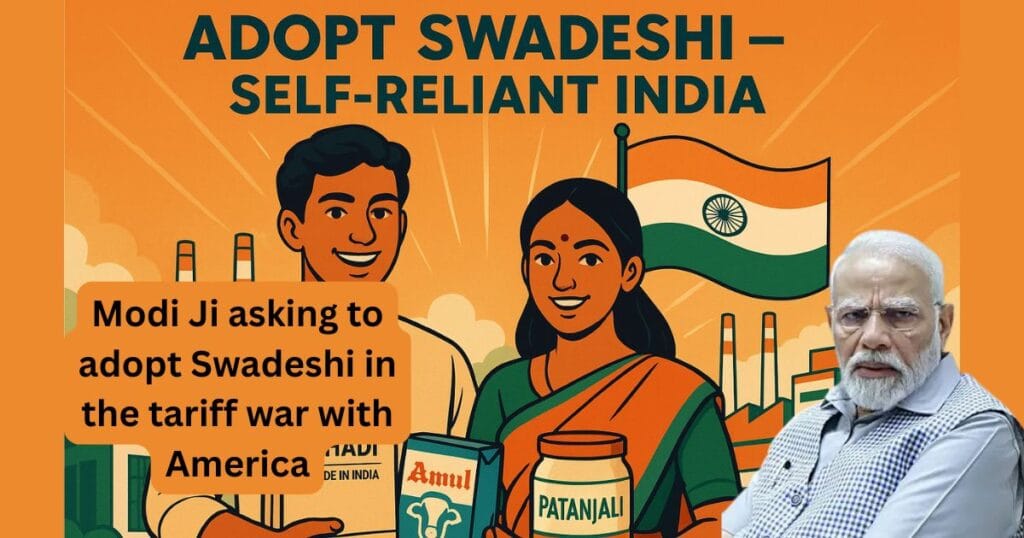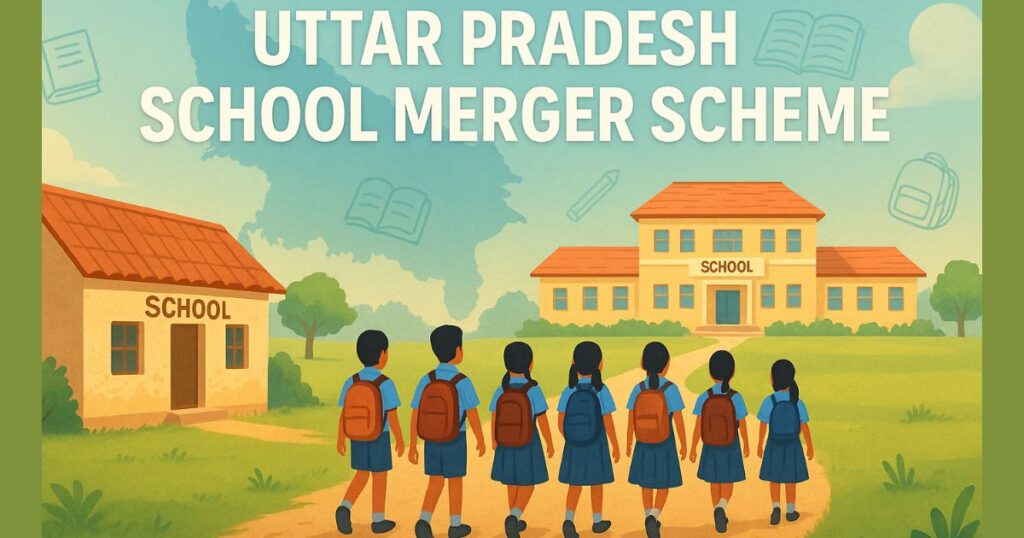Prime Minister Narendra Modi’s call to Adopt Swadeshi has become a rallying cry for every Indian. This slogan is not just about buying locally made products; it’s a vision to make India economically and socially self-reliant. But is Swadeshi merely a slogan, or is it truly the need of the hour? In this article, we’ll break down this movement in simple language, covering tariff wars, the difference between Swadeshi and foreign products, the progress of Atmanirbhar Bharat, and how ordinary citizens and the government can make this vision a reality.

The Meaning and Importance of Adopt Swadeshi
The Purpose of adopt Swadeshi
Adopt Swadeshi means prioritizing products made in India, such as khadi clothes, Amul dairy, or Patanjali soaps. By choosing Swadeshi, we support our local factories, artisans, and small businesses. This creates jobs, strengthens rural economies, and keeps our money within the country.
Summary of PM Modi’s Speech
PM Modi launched the Atmanirbhar Bharat (Self-Reliant India) campaign in 2020, with adopt Swadeshi as a key pillar. In his speeches, he emphasizes that buying Swadeshi is an act of patriotism. He said, “Every Indian must pledge to buy Swadeshi products to make India self-reliant.” This movement aims to make India independent in sectors like defense, pharmaceuticals, and electronics.
Connection to Atmanirbhar Bharat
The adopt Swadeshi movement is a vital part of Atmanirbhar Bharat. The goal is to make India self-sufficient in every field. For example, buying Indian-made mobile phones or medicines reduces our reliance on imports. This keeps our money in the country and strengthens our economy.
Key Quotes:
- “Buying Swadeshi is not just shopping; it’s a way to provide jobs to our people.”
- “Atmanirbhar Bharat means trusting our resources and showing the world that India is second to none.”
Tariff War: How Is It Affecting India?
What Is a Tariff War?
A tariff war happens when countries impose high taxes (tariffs) on imported goods, making them more expensive and reducing trade. For instance, if the US puts a high tax on Indian goods, they become costlier there, and people may buy less.
The US-China Trade War
The US and China have been in a tariff war for years. Recently, the US announced a 25% tariff on Indian imports, effective from August 2025. This could hurt India’s exports, especially in sectors like textiles, pharmaceuticals, and shrimp.
Impact on India
- Rising Prices: Foreign goods may become more expensive, forcing Indian consumers to pay more.
- Supply Chain Disruptions: If we can’t import affordable electronics parts from China, our factories may face production delays.
- Export Decline: In 2024, India exported $87 billion worth of goods to the US. Tariffs could reduce this.
- Shrimp Exports: India’s shrimp exports, worth $4.88 billion, with half going to the US, are at risk.
- Trade Deficit: India’s trade deficit (currently $45.7 billion) may widen as we import more but export less.
Adopt Swadeshi vs. Foreign Products: What’s the Difference?
Local vs. Global Brands
Adopt Swadeshi products are made in India, like Dabur honey, Amul milk, or khadi fabrics. Foreign products come from abroad, such as Colgate toothpaste, Nike shoes, or Apple phones. Here’s how they compare:
- Quality: Foreign brands are often seen as higher quality due to advanced technology and branding. However, Swadeshi brands like Patanjali and Amul are improving their quality and gaining global recognition.
- Price: Foreign products, like electronics, can be cheaper due to large-scale production. Swadeshi products are often affordable and tailored to local needs.
- Economic Impact: Buying Swadeshi creates jobs in India and keeps money in the country. Foreign products send our money abroad, weakening our economy.
Impact on Self-Reliance
- Swadeshi Products: They support local factories and artisans. For example, khadi provides jobs to millions of weavers.
- Foreign Products: Dependence on them reduces our technical and economic independence. For instance, India once relied heavily on China for pharmaceutical raw materials, though this is decreasing.
Atmanirbhar Bharat: Progress So Far
The Atmanirbhar Bharat campaign, launched in 2020, aims to make India self-reliant in all sectors. Here’s what has been achieved:
Key Schemes
- Make in India: This has boosted local manufacturing, with mobile phones, TVs, and defense equipment now made in India.
- PLI Scheme (Production Linked Incentive): Launched for 13 sectors like electronics and pharmaceuticals, it encourages investment and boosts exports.
- Defense Sector: The government listed 108 defense items to be made only in India from 2021 to 2025.
- Agriculture and Rural Development: Schemes like Minimum Support Price (MSP) and Gram Swaraj Abhiyan support farmers and rural economies.
Achievements
- India’s economy grew by 8.2% in 2023-24, with a projected 7% growth in 2024-25.
- Foreign exchange reserves reached $670 billion, covering over 11 months of imports.
- India is becoming a major exporter of mobile phones and electronics.
Challenges
- During COVID, vaccine shortages forced India to import vaccines.
- Tariff wars and supply chain issues are hindering production.
Aatmanirbhar Bharat Rojgar Yojana (ABRY)
India’s Economy and Global Competitiveness
India is currently the world’s fourth-largest economy and is on track to become the third largest by 2030. However, we need to work harder to compete globally.
Current Status
- India’s GDP was $3.73 trillion in 2023.
- Make in India has boosted manufacturing, contributing 17% to GDP.
- Exports are growing, with a $1 trillion target by 2030.
Global Competitiveness
- India’s share in global textile exports dropped from 4% in 2018 to 3% in 2022 due to high production costs.
- The National Logistics Policy aims to reduce trade costs and improve efficiency.
Challenges and Opportunities
- Challenges: Unemployment (17% among urban youth) and high production costs.
- Opportunities: India has potential in IT, pharmaceuticals, textiles, and green technology.
The Role of Citizens: Are We Adopting Swadeshi?
Ordinary citizens play a crucial role in adopting Swadeshi, but many still prefer foreign products.
Public Sentiment
- Some people feel India lacks high-quality Swadeshi electronics and phones.
- Others believe adopting Swadeshi strengthens the nation’s economy.
Social Media and Digital Campaigns
- Campaigns like #VocalForLocal encourage people to buy Swadeshi.
- Organizations like Swadeshi Jagran Manch are spreading awareness online.
Challenges
- Foreign products are often cheaper and of better quality.
- Swadeshi products need improvements in price and quality.
What Can the Government Do?
To promote Adopt Swadeshi, the government needs to take further steps:
- Tariff Policy: Increase taxes on foreign products to make Swadeshi goods more competitive.
- Support Local Brands: Strengthen the PLI scheme to boost local manufacturing.
- Boost Exports: Promote agricultural and food product exports.
- Improve Quality: Invest in training and technology to enhance Swadeshi product quality.
ALSO READ- Prime Minister Modi’s Historic Brazil Visit 2025: A New Chapter in India-Brazil Relations
Is a tariff war an opportunity or a threat for India?
It’s both. Tariff wars can hurt our exports, like shrimp and textiles, but they also give us a chance to promote Adopt Swadeshi and reduce reliance on imports.
How to identify Swadeshi products?
Look for “Made in India” on the packaging. Choose brands like Amul, Dabur, or khadi.
Does adopting Swadeshi save money?
In the long run, buying Swadeshi keeps money in India, strengthening the economy. However, some Swadeshi products may currently be pricier, so quality and price improvements are needed.
Conclusion: Is Adopt Swadeshi a Slogan or a Necessity?
Adopt Swadeshi is not just a slogan; it’s a necessity for India’s future. It will strengthen our economy, create jobs, and make India a global powerhouse. However, this requires collective effort from the government, businesses, and citizens. If we all pledge to buy Swadeshi, India can become truly Atmanirbhar and shine on the world stage.
Do you also use any indigenous products? Please tell us in the comments below.


